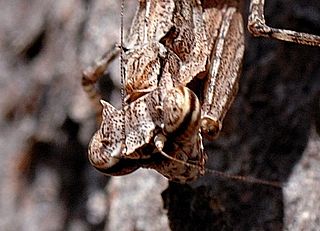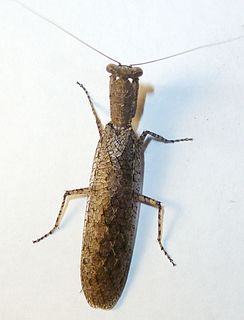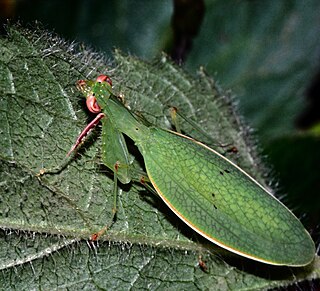
Mantis shrimp, or stomatopods, are carnivorous marine crustaceans of the order Stomatopoda, branching from other members of the class Malacostraca around 340 million years ago. Mantis shrimps typically grow to around 10 cm (3.9 in) in length, while a few can reach up to 38 cm (15 in). A mantis shrimp's carapace covers only the rear part of the head and the first four segments of the thorax. Varieties range in color from shades of brown to vivid colors, with more than 450 species of mantis shrimps being known. They are among the most important predators in many shallow, tropical and subtropical marine habitats. However, despite being common, they are poorly understood, as many species spend most of their lives tucked away in burrows and holes.

Mantidae is one of the largest families in the order of praying mantises, based on the type species Mantis religiosa; however, most genera are tropical or subtropical. Historically, this was the only family in the order, and many references still use the term "mantid" to refer to any mantis. Technically, however, "mantid" refers only to members of the family Mantidae, and not the 14 remaining families of mantises. Some of the most recent classifications have promoted a number of the mantid subfamilies to the rank of family, e.g. Iridopterygidae, Sibyllidae, Tarachodidae, Thespidae, and Toxoderidae, while other classifications have reduced the number of subfamilies without elevating to higher rank.

The mantis family Metallyticidae consists of a single small genus, Metallyticus, living mostly in South-East Asia. The species are dark, somewhat flattened and cockroach-like, often with a cuticle that is reflective and metallic in appearance.

Sibylla pretiosa, commonly known as the cryptic mantis, is a species of mantis found in southern Africa. They have a long and thin prothorax. The distinctively ornamented species has projections on the head, prothorax, and four femora. They live on tree bark in woodlands.

Flower mantises are those species of praying mantises that mimic flowers. Their coloration is an example of aggressive mimicry, a form of camouflage in which a predator's colours and patterns lure prey. The flower mantises are not a natural group with a single ancestor, but most of the species are in the family Hymenopodidae. Their behaviours vary, but typically involve climbing a plant, and then staying still until a prey insect comes within range. Many species of flower mantises are popular as pets.

Paraoxypilus is a genus of mantis, known as the boxer bark mantises. They are native to Australia and Oceania.

Gyromantis kraussi, the spiny bark mantis, is a member of the mantis family. It is native to Australia.

Metallyticus splendidus is a rare species of praying mantis found in Southeast Asia. It has an iridescent appearance.

African mantis and African praying mantis are common names for many species of praying mantis native to Africa.

Bark mantis is a common name given to various species of praying mantis, especially those with cryptic camouflage resembling tree bark. Examples include:
Gyromantis occidentalis, commonly known as the eastern bark mantis, is a species of mantis found in Australia.

Tarachodidae is a now obsolete family in the order Mantodea, of genera found in Africa and Asia.

The bark mantises and ground mantises are praying mantids now placed in the family Eremiaphilidae that are native to the Afrotropics. They are generally light brown but more silvery on the wings. The wings are attractively reticulated, and the veins may be mottled dark and pale. The head is wider than the pronotum, which is rounded anteriorly, and doesn't overlap with the rear of the head. The pronotum is depressed, with its sides more or less parallel, and only a weak supra-coxal bulge is present. The anterior tibia are flattened and greatly expanded longitudinally, and the tibial claw does not fit into a pit between the 1st and 2nd external spines of the anterior femora, as in a few mantis groups.
Tarachodes afzelii, commonly known as the Tanzanian ground mantis, is a species of praying mantis in the family Eremiaphilidae. It is native to woodland in Western and Central Africa.
Tarachodes maurus is a species of praying mantis in the family Eremiaphilidae. It was first described by the Swiss entomologist Henri Louis Frédéric de Saussure in 1871. It has been placed in either subgenus Chiropacha or subgenus Tarachodes.

Mantises are an order (Mantodea) of insects that contains over 2,400 species in about 430 genera in 33 families. The largest family is the Mantidae ("mantids"). Mantises are distributed worldwide in temperate and tropical habitats. They have triangular heads with bulging eyes supported on flexible necks. Their elongated bodies may or may not have wings, but all Mantodea have forelegs that are greatly enlarged and adapted for catching and gripping prey; their upright posture, while remaining stationary with forearms folded, has led to the common name praying mantis.
Ceratocrania macra is a mantis in the family Hymenopodidae. The English common name is bark horned mantis. No subspecies are listed. It is found in Java, Borneo, and Sumatra.
Metallyticus fallax is a species of praying mantis, found in Southeast Asia. It has an iridescent appearance. It is very similar to the Metallyticus splendidus.

The Nanomantidae are a new (2019) family of praying mantises, based on the type genus Nanomantis. As part of a major revision of mantid taxonomy, genera and tribes have been moved here, substantially replacing the old family Iridopterygidae.












